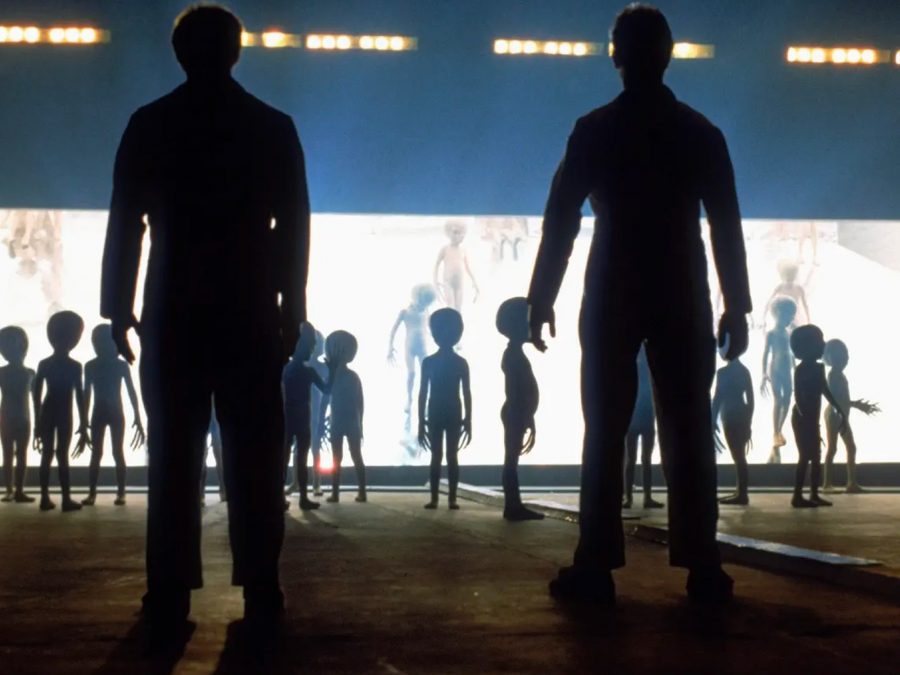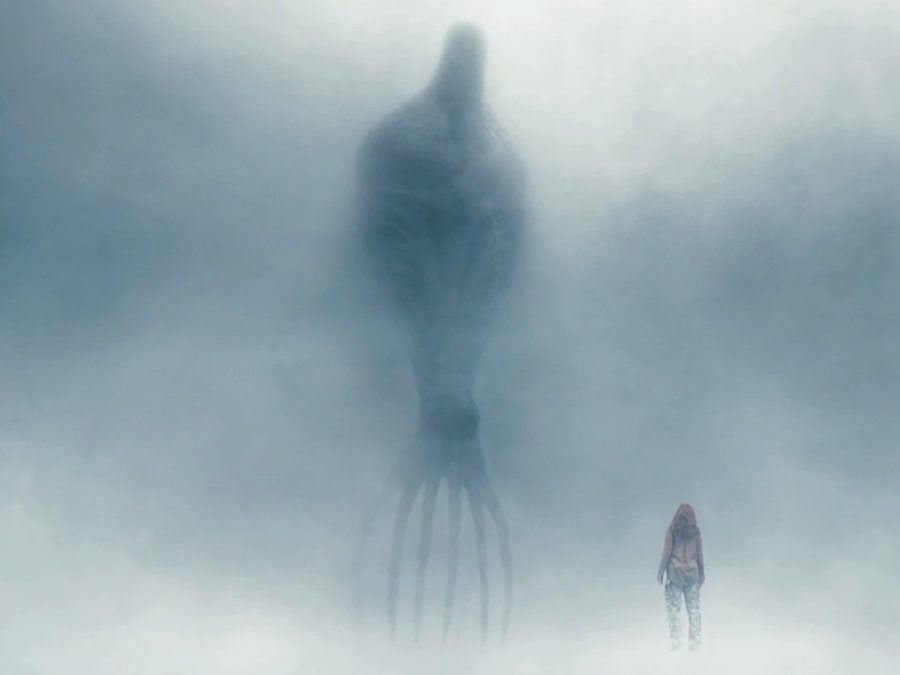Earlier this year, three ex-military officers presented testimony to U.S. Congress detailing sightings of Unidentified Anomalous Phenomena (“UAPs”, as UFOs are now called). Just like the one sparked by the Roswell incident in the 1950s, we could be about to see a surge in films about UFOs (let’s face it – it’s catchier than UAPs). Far from being pure escapist fantasy, science fiction has always been a way of talking about the times we live in – what might our enduring interest in the proposition of alien visitors reveal about ourselves?
With Close Encounters of the Third Kind (1977) Spielberg gave the world one of the definitive UFO movies. What’s curious about this take – a working-class family man becoming obsessed with flying saucers – is the relative lack of military involvement. When we aren’t following electrician Roy Neary (Richard Dreyfuss), we’re watching scientists scrambling to investigate the phenomena, readying to greet the visitors in peace. This is a film about excitement, not hostility. Roy races towards the aliens, not away. The UFOs themselves are toylike – multicoloured, bright and round, communicating through song, children chasing after them. In a conversation between Roy and his wife, they are compared to comfort food: ice cream cones, tacos and cookies. Consumerism looms large, ‘60s optimism congealed into ‘70s capitalist humdrum, with Roy desperate to escape the suburbs and perpetual daytime TV for a more stimulating life. ‘It’s like Halloween for grown-ups’, says fellow obsessive Jillian (Melinda Dillon) as they gaze up at the sky.
Spielberg’s next foray into science fiction, this time penned by Melissa Mathison, gave us another iconic story framed by UFOs. In E.T. the Extra-Terrestrial (1982), the alien ship resembles those from Close Encounters, as charming as the childlike beings that call it home, painting rainbows in its wake. It arrives to collect plants, steering clear of humans and forest fauna. When a shadowy mob causes E.T. to become stranded from his spaceship, it’s clear that UFOs aren’t the threat here, we are. With the exception of Elliot’s mother, it’s an hour and 20 minutes before we clearly see an adult’s face – their motives are cryptic and not to be trusted, with Elliot (Henry Thomas) and E.T. forming a closer bond than the boy ever had with his absent father. Shots of exhaust pipes are contrasted with E.T.’s vegetarianism and healing powers, showing adults to be ignorant and less evolved. When Elliot shows E.T. the treasures in his room, he unknowingly gives examples of war, the food chain, money and cars, echoing society’s misguided values. The government is motivated by ownership rather than excitement or curiosity, encapsulating the ‘80s “greed is good” mentality at the expense of living things.

In the ‘90s, all innocence went out the window. So far, nobody had discussed the possibility of invasion – in Roland Emmerich’s Independence Day (1996) it goes without saying. The first shot is an American flag planted firmly on the Moon, before we move to scientists portrayed much less favourably than in Spielberg’s films. The Pentagon is where the real work takes place and the military is very much in charge, with advisors rushing to brief the President (Bill Pullman) – an ex-fighter pilot himself. The Secretary of Defense lobbies to blow up the spaceships, and who can blame him when these UFOs are ominous black slabs 15 miles in diameter, trailing storm clouds, blocking out the sun? Paranoia is justified and “might is right” (the most celebrated part of the movie is when Will Smith punches an alien in the face). This is a UFO film made at “the end of history” – Western liberal democracy emerging from the Cold War triumphant.
By the time M Night Shyamalan made Signs (2002), things had shifted again in the American consciousness. The sabre-rattling fades as we focus on the perspective of an ordinary family in rural Pennsylvania. The characters are vulnerable and confused, with nobody really sure what the crop circles are, or why 14 lights have appeared in the sky. Maybe it’s a hoax, maybe it’s the end of the world. The reason almost doesn’t matter – in Signs extraterrestrials are incidental. More important is the central question about faith: is it hollow comfort, or an essential ingredient for survival? In one of the film’s most chilling scenes, Graham (Mel Gibson), a priest who left the church after the senseless death of his wife, tells his frightened younger brother Merrill (Joaquin Phoenix) ‘There is no one watching out for us, Merrill. We are all on our own.’ In a post-9/11 landscape, this is less a story about visitors from outer space and more about grief, faith through adversity, and coming together in a world turned upside down.
With Denis Villeneuve’s Arrival (2016), UFOs were no longer part of an invading force, with scientists (or rather academics) back in the driver’s seat. Humans are now their own worst enemy – whatever war happens will be of our own making. From the moment the “shells” arrive, people lose their minds. Fighter jets roar overhead, cars crash as people rush to get home. The public loots shops and panic buys gas, water and food. A group of radicalised, alt-right soldiers plant a bomb in one of the ships. It all seems quite likely, and close to the bone. Arrival came out at a time when Trump was in the ascendant, and Brexit was on the horizon. There was a shortage of common sense and goodwill, and it felt as though something of this magnitude was needed to make us cooperate. With the arrival of the shells – crafts that omit no waste or radiation, which at first appear to resemble eggs or seeds – the world is able to see itself as a united planet for the first time, all nations agreeing to put aside their differences to exchange knowledge for the betterment of humankind. If only.

Jordan Peele’s Nope (2022) brings us more or less to the present day, with a film about show business, fame and our relationship with nature. Success doesn’t come easily for OJ (Daniel Kaluuya) and Emerald (Keke Palmer), and the only hope of escaping the daily grind is to become ‘rich and famous for life’ with a UFO video – something they’re prepared to risk their lives for. But this time we’re not dealing with a spacecraft, the UFO the characters are hunting is a growling, territorial ‘animal’ that ‘thinks this is its home’. For once, the universe doesn’t revolve around humans. This UFO hasn’t come to study us, attack us or save us from ourselves. Yes, it eats their horses and inadvertently kills their father, but crucially this is a thing in itself, a zoomorphic being lashing out at a species trying to exploit it. ‘Anything with a spirit can get broke,’ says unhinged cinematographer Holst (Michael Wincott), and break its spirit they do, but not before Emerald triumphantly gets the evidence she needs to go on Oprah. Is this a happy ending or an indictment of our self-serving, self-centred internet age?
Surprisingly, the 2023 congressional hearing on UFOs didn’t hang around for long in the news cycle, swiftly replaced by more earthly concerns. In the end, testimony about flying saucers failed to bring excitement, panic or even introspection to a cynical public. This indifference also runs through the heart of Nope: when Angel (Brandon Perea) makes an impassioned speech about the potential wonders and horrors of UFOs, OJ gives a disinterested one-word reply: ‘Cool.’
The post Close Encounters: 50 years of UFO cinema appeared first on Little White Lies.
from Little White Lies https://ift.tt/XDErntW
via IFTTT

0 Comments